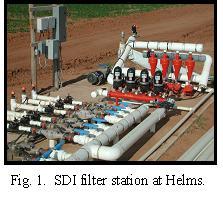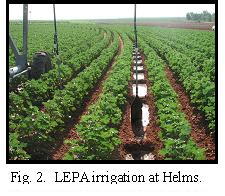James P. Bordovsky, Doug Nesmith, Joe Mustian, and Stacey Ontai
 Objective: The objective was to compare subsurface drip irrigation (SDI) to the LEPA irrigation method in terms of cotton lint yield and irrigation quantities on a farm scale. Methodology: Interest in SDI continues to grow as water availability decreases and opportunities for government cost share becomes available. Questions related to the economics of cotton production using SDI compared to pivot irrigation are often asked. The Helms Research Farm at Halfway provides a unique, controlled environment to answer these type questions. In 2002, cotton was produced on 71 acres of SDI and 84 acres irrigated with LEPA. Details of SDI and LEPA irrigated cotton experiments are contained in the following reports. This report, however, summarizes average cotton lint yields and irrigation amounts resulting from the use of these two systems. Problems typical of production scale agriculture in the area were encountered at this site in 2002.
Objective: The objective was to compare subsurface drip irrigation (SDI) to the LEPA irrigation method in terms of cotton lint yield and irrigation quantities on a farm scale. Methodology: Interest in SDI continues to grow as water availability decreases and opportunities for government cost share becomes available. Questions related to the economics of cotton production using SDI compared to pivot irrigation are often asked. The Helms Research Farm at Halfway provides a unique, controlled environment to answer these type questions. In 2002, cotton was produced on 71 acres of SDI and 84 acres irrigated with LEPA. Details of SDI and LEPA irrigated cotton experiments are contained in the following reports. This report, however, summarizes average cotton lint yields and irrigation amounts resulting from the use of these two systems. Problems typical of production scale agriculture in the area were encountered at this site in 2002.
 Results: The 2002 crop year was favorable for cotton production, however, problems occurred. The growing season was unusually dry with only 1.4 inches of rainfall from 3 May to 28 August. The lack of early season rainfall and the typical high winds and low humidity at planting caused seed germination problems in SDI areas. Large drip irrigations applied to achieve germination diluted planter applied insecticides requiring foliar insecticide battles with thrip. Young cotton plants in all areas struggled due to cool temperatures and slow growth with one LEPA irrigated area being replanted. Additional problems related to an accidental commercial chemical application on the LEPA irrigated, ultra-narrow row cotton experiment resulted in lower yields and abandonment of several acres within this test. The biggest challenge, however, was overcoming drip emitters plugged by manganese oxide in one SDI area. This problem was eventually resolved.Considering the challenges, cotton yields were very high. SDI cotton yields averaged 1113 lb/ac using 18.5 inches of irrigation compared to LEPA yields of 1204 lb/ac using an average of 15.7 inches. Drip yields from various experiments ranged from 800 to over 2040 lb/acre; LEPA yields, from 900 to 1800 lb/acre. Although SDI is generally more water efficient than pivot irrigation, situations arise where this is not always the case.
Results: The 2002 crop year was favorable for cotton production, however, problems occurred. The growing season was unusually dry with only 1.4 inches of rainfall from 3 May to 28 August. The lack of early season rainfall and the typical high winds and low humidity at planting caused seed germination problems in SDI areas. Large drip irrigations applied to achieve germination diluted planter applied insecticides requiring foliar insecticide battles with thrip. Young cotton plants in all areas struggled due to cool temperatures and slow growth with one LEPA irrigated area being replanted. Additional problems related to an accidental commercial chemical application on the LEPA irrigated, ultra-narrow row cotton experiment resulted in lower yields and abandonment of several acres within this test. The biggest challenge, however, was overcoming drip emitters plugged by manganese oxide in one SDI area. This problem was eventually resolved.Considering the challenges, cotton yields were very high. SDI cotton yields averaged 1113 lb/ac using 18.5 inches of irrigation compared to LEPA yields of 1204 lb/ac using an average of 15.7 inches. Drip yields from various experiments ranged from 800 to over 2040 lb/acre; LEPA yields, from 900 to 1800 lb/acre. Although SDI is generally more water efficient than pivot irrigation, situations arise where this is not always the case.
Table 1. Average lint yield and irrigation water used on pivot and subsurface drip irrigated areas at the Helms Farm, 2002.
| Pivot (LEPA) | Subsurface Drip | |
| Area (acres) | 83.64 | 70.75 |
| Irrigation volume used (ac-inches) | 1814 | 1307 |
| Average total irrigation (inches) | 15.71 | 18.47 |
| Cotton lint sold (lbs) | 101,154 | 79,746 |
| Average yield (lbs/acre) | 1209 | 1127 |





